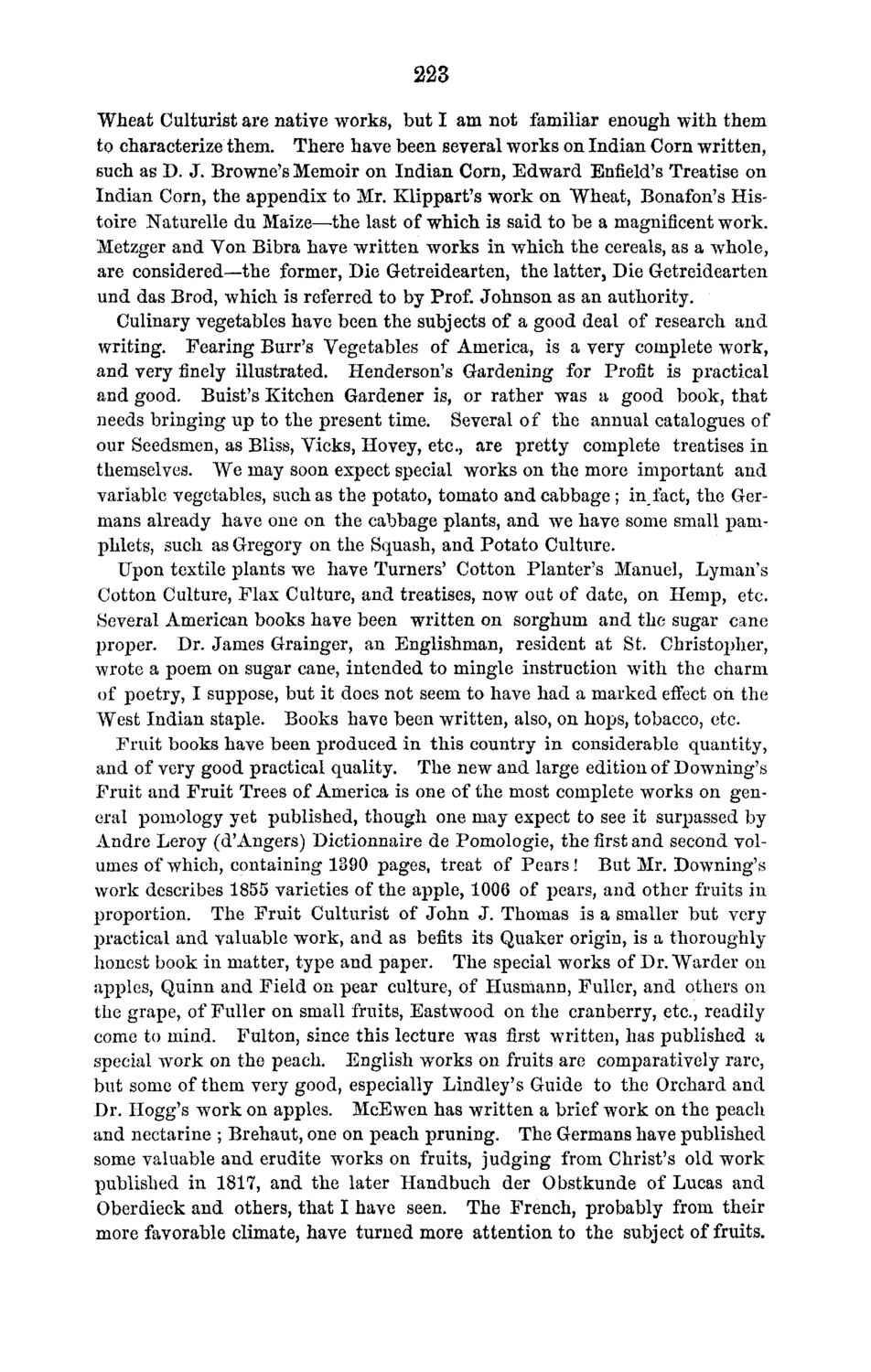| |
| |
Caption: Board of Trustees Minutes - 1870
This is a reduced-resolution page image for fast online browsing.

EXTRACTED TEXT FROM PAGE:
223 Wheat Culturist are native works, but I am not familiar enough with them to characterize them. There have been several works on Indian Corn written, such as D. J. Browne's Memoir on Indian Corn, Edward Enfield's Treatise on Indian Corn, the appendix to Mr. Klippart's work on Wheat, Bonafon's Histoire Naturelle du Maize—the last of which is said to be a magnificent work. Metzger and Von Bibra have written works in which the cereals, as a whole, are considered—the former, Die Getreidearten, the latter, Die Getreidearten und das Brod, which is referred to by Prof. Johnson as an authority. Culinary vegetables have been the subjects of a good deal of research and writing. Fearing Burr's Vegetables of America, is a very complete work, and very finely illustrated. Henderson's Gardening for Profit is practical and good. Buist's Kitchen Gardener is, or rather was a good book, that needs bringing up to the present time. Several of the annual catalogues of our Seedsmen, as Bliss, Vicks, Hovey, etc., are pretty complete treatises in themselves. We may soon expect special works on the more important and variable vegetables, such as the potato, tomato and cabbage; in, fact, the Germans already have one on the cabbage plants, and we have some small pamphlets, such as Gregory on the Squash, and Potato Culture. Upon textile plants we have Turners' Cotton Planter's Manuel, Lyman's Cotton Culture, Flax Culture, and treatises, now out of date, on Hemp, etc. Several American books have been written on sorghum and the sugar cane proper. Dr. James Grainger, an Englishman, resident at St. Christopher, wrote a poem on sugar cane, intended to mingle instruction writh the charm of poetry, I suppose, but it does not seem to have had a marked effect on the West Indian staple. Books have been written, also, on hops, tobacco, etc. Fruit books have been produced in this country in considerable quantity, and of very good practical quality. The new and large edition of Downing's Fruit and Fruit Trees of America is one of the most complete works on general pomology yet published, though one may expect to see it surpassed by Andre Leroy (d'Angers) Dictionnaire de Pomologie, the first and second volumes of which, containing 1390 pages, treat of Pears ! But Mr. Downing's work describes 1855 varieties of the apple, 1006 of pears, and other fruits in proportion. The Fruit Culturist of John J. Thomas is a smaller but very practical and valuable wTork, and as befits its Quaker origin, is a thoroughly honest book in matter, type and paper. The special works of Dr. Warder on apples, Quinn and Field on pear culture, of Husmann, Fuller, and others on the grape, of Fuller on small fruits, Eastwood on the cranberry, etc., readily come to mind. Fulton, since this lecture was first written, has published a special work on the peach. English wTorks on fruits are comparatively rare, but some of them very good, especially Lindley's Guide to the Orchard and Dr. Hogg's work on apples. McEwen has written a brief work on the peach and nectarine ; Brehaut, one on peach pruning. The Germans have published some valuable and erudite works on fruits, judging from Christ's old work published in 1817, and the later Handbuch der Obstkunde of Lucas and Oberdieck and others, that I have seen. The French, probably from their more favorable climate, have turned more attention to the subject of fruits.
| |